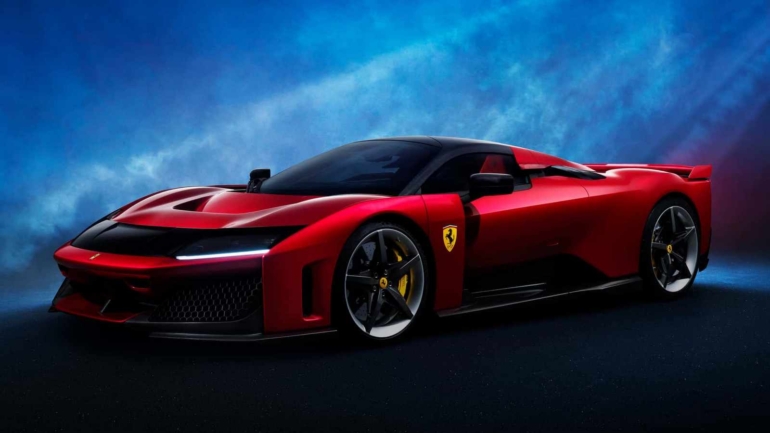This is it! After months of anticipation, Ferrari has finally introduced the new chapter of its flagship model family. Behold the Ferrari F80, the Italian automaker’s newest halo car that aims to be the gold standard of the hypercar segment just like its predecessors. Originally recognized by its code name F250, the hybrid hypercar was named F80 as a nod to the 80th anniversary of the Ferrari as a carmaker. Here are some of the important things you should know about Ferrari’s new flagship.

A new design direction for Ferrari
Ferrari halo cars come along once a decade, ushering in a new design language that percolates to other production models. The new F80 is no different. However, the latest flagship model’s design can be described as polarizing thanks to its striking and unusual approach. Instead of using the curvaceous design language of the LaFerrari, the F80 features a square design with lots of straight lines and boxy elements. If you look closely, the hypercar’s styling appears to be inspired by the legendary F40, especially the fenders. Ferrari says the F80’s design was the result of a new approach that saw the Style Centre and the aerodynamic and engineering departments work together closely, helping form and function blend together seamlessly. The front is dominated by the Daytona-inspired headlight “visor” that was deliberately added to avoid the humanoid look of “two eyes, one mouth”, according to Ferrari chief design officer Flavio Manzoni.
A hypercar designed around aerodynamics
It’s not very hard to recognize that the entire design of the F80 is built around optimizing the airflow around the hypercar to produce maximum downforce while minimizing drag. With aero cues from F1, every part of the hypercar’s body has been designed in a way that channels air optimally. The front features a massive S-Duct with active flaps that alone produces a whopping 1,014 pounds of downforce at 155 miles per hour. The rear gets an active wing and a massive 71-inch diffuser, which adds another 1,300 pounds of downforce. According to Ferrari, the F80 produces a total of 2,204 pounds of downforce at 155 mph.
A fresh approach to cabin layout
If you look closely, you will notice that the F80 features a very narrow cabin, which is almost masked by the hypercar’s broad shoulders. However, it’s not until the butterfly doors of the flagship model are opened that you’ll realize that the cabin is nothing like you’ve seen before. The F80 boasts a cabin layout with the passenger seat slightly behind the driver’s seat. Ferrari calls it a “+1”, with everything inside the cockpit oriented towards the driver. The control panel is angled toward the driver, while the passenger only gets a small digital display on the dashboard. Furthermore, the driver’s seat is a bright red adjustable sport bucket, while the passenger seat is black and fixed to the chassis. The cockpit also features a new, squared steering wheel.
A bold powertrain choice
The most debatable aspect of Ferrari’s new halo model is its powertrain. While most of F80’s predecessors were powered by the marque’s glorious naturally aspirated V12, the new flagship features a V6 engine assisted by three electric motors. While it’s a bold choice to festoon a six-cylinder engine in a halo car, there’s a good reason why Ferrari chose to do that. The F80’s V6 is a nod to its motorsports pedigree, especially Ferrari’s F1 race car. The 3.0-liter V6 is very similar to the 120-degree, hot-v engine from the 296 sports car and the highly successful 499P Le Mans race car. However, it makes 888 horsepower and 627 pound-feet of torque all on its own, which is significantly higher. Another 296 hp is delivered by a trio of electric motors, taking the combined output to 1,184 hp (1,200 PS).
Almost as quick as the quickest EVs
Two electric motors are placed at the nose to power the front wheels, while the third motor performs three basic functions: starter motor for the gas engine, recovering energy, and providing additional torque when needed. Strangely, the F80 doesn’t have an EV-only mode. However, it is the most powerful road car ever to be made by Ferrari thanks to its total output of 1,184hp. As a result, the F80 can accelerate from 0-62mph in just 2.15 seconds, which is blisteringly quick. The hypercar takes 5.75 seconds to reach 125mph and has an electronically limited top speed of 217.5mph.
Not as rare but still unattainable
Ferrari has announced that it will build 799 examples of the F80, which is an unusually high number for a halo car. In comparison, Ferrari produced only 499 units of the LaFerrari coupe, while Enzo’s production was limited to 400 examples. Nevertheless, the F80 has a starting price of €3.6 million (about $4 million USD at current conversion rates), which makes it the most expensive new Ferrari of all time. Yet, Ferrari says all the 799 F80 units were spoken for even before the hypercar debuted. Production will begin at the end of 2025 and will last until 2027.







